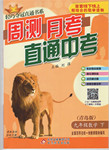题目内容
When an ant dies, other ants take it out of the nest, often within an hour after its death. This behavior interests scientists and they wonder how ants know for sure—and so soon—that another ant is dead.
One scientist recently came up with a way to explain this ant behavior. Dong-Hwan Choe is a biologist, a scientist who studies animals and plants. He found that ants have a chemical on the outside of their bodies that signals to other ants, “I'm dead—take me away” when it is dead.
But there's a question to answer: As we know, if an ant is dead, it stops moving. But when an ant is sleeping or knocked unconscious, it is also not moving. However, other ants don't move the living ant out of the nest. How do they know this ant is not dead? Choe found that ants have another chemical on their bodies, which tells nearby ants something like, “Wait—I'm not dead yet” when it is not dead. Choe suspects that when an ant dies, the chemical that says, “Wait— I'm not dead yet” quickly goes away. When other ants detect the “dead” chemical without the “not dead yet” chemical, they move away the body.
To test his theory, Choe and his team put different chemicals on ants. When the scientists used the “I'm dead” chemical, other ants quickly moved the treated ant away. When the scientists used the “Wait—I'm not dead yet” chemical, other ants left the treated ant alone. Choe believes this behavior shows that the “not dead yet” chemical is stronger than the “dead” chemical when picked up by other ants. And that when an ant dies, the “not dead yet” chemical fades away. Other nearby ants then detect the remaining “dead” chemical and remove the body from the nest.
Understanding this behavior can help scientists figure out how to stop ants from invading new places and causing problems.
1.What is the function of the first paragraph?
A. Leading the following paragraphs.
B. Showing the main idea of the passage.
C. Introducing the background of the passage.
D. Giving a summary of the passage.
2.What can we learn from the passage?
A. Living ants can also be taken away when they are not moving.
B. When an ant dies, it can tell others using a certain chemical.
C. A living ant can pretend to be dead using a special chemical.
D. Ants often use chemicals to communicate with each other.
3.Which of the following descriptions about Dong-Hwan Choe is right?
A. Choe did this study in order to stop ants from invading new places.
B. Choe is a biologist who is only interested in animals, especially in ants.
C. Choe first came up with an idea to explain this ant behavior, and then did some tests to prove his theory.
D. Choe did the research on this ant behavior on his own.
4.What is mainly discussed in the passage?
A. experiments about how ants manage to keep their nests clean.
B. experiments about why ants have special chemicals on their bodies.
C. experiments about why ants can have this removal behavior
D. experiments about how to decide whether an ant is dead or not.
1.A
2.B
3.C
4.C
【解析】
试题分析:文章主要介绍了科学家研究蚂蚁搬尸体行为的实验。当一只蚂蚁死了,其它蚂蚁就会把它搬出巢穴,通常发生在它死后一小时之内。这种行为引起了科学家的兴趣,他们想知道蚂蚁们是怎样那么快就明确地知道了有蚂蚁死的消息。
1.“When an ant dies, other ants take it out of the nest, often within an hour after its death. This behavior interests scientists and they wonder how ants know for sure—and so soon—that another ant is dead.”当一只蚂蚁死了,其它蚂蚁就会把它搬出巢穴,通常发生在它死后一小时之内。这种行为引起了科学家的兴趣,他们想知道蚂蚁们是怎样那么快就明确地知道了有蚂蚁死的消息。接下来讲的是科学家做的实验。第一段起到提纲挈领的作用,引入接下来的内容。故选A。
2.根据第二段“ants have a chemical on the outside of their bodies that signals to other ants, “I'm dead—take me away” when it is dead.”可知,蚂蚁身体表面有一种化学物质,能够告诉其它蚂蚁它的死讯。故选B。
3.根据第三“Choe suspects that when an ant dies, the chemical that says, “Wait— I'm not dead yet” quickly goes away. When other ants detect the “dead” chemical without the “not dead yet” chemical, they move away the body.”和第四段“To test his theory, Choe and his team put different chemicals on ants.”可知,Choe有了新发现,并做了实验来检验。故选C。
4.文章主要介绍了Choe的实验,研究蚂蚁怎样确定一只蚂蚁是否死掉,并搬走死亡蚂蚁的行为。故选C。
考点:自然科学类短文阅读

 轻巧夺冠周测月考直通中考系列答案
轻巧夺冠周测月考直通中考系列答案